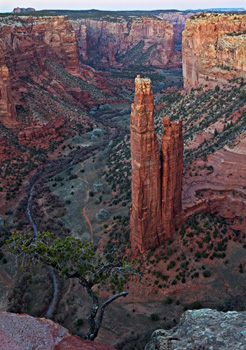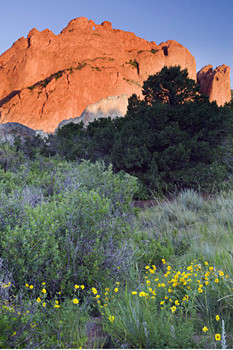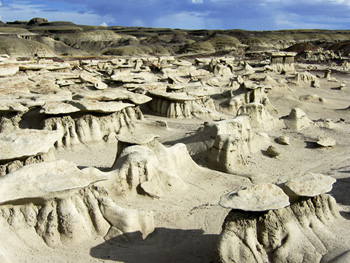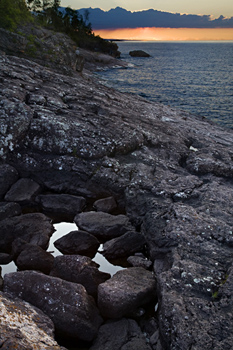Learn how and when to shoot landscape photos, sunrise photos, sunset photos and low-angle light photos.
I sat at dinner in Farmington, New Mexico, with a view to a bluff just a few hundred yards to the south. For three minutes (I timed it), the setting sun lit up that bluff and turned it brilliant shades of gold and ocher. Then the sun dropped just a bit in the western sky, the light changed, and all the color faded away, leaving the bluff just dull brown. It was a stunning example of the fleeting nature of landscape photography and reminded me of the adage – perfect for those of us who love to capture the beauty and wonder of the natural world – that “timing is everything.”

Copyright 2007 Christopher K. Sandberg
Landscape photographers often talk of the “golden hour”, but what do they really mean? The “golden hour” refers to the fleeting period around sunrise and sunset when light does wonderful things for photography.
There are several reasons why you should leave your comfortable bed and venture afield well before reasonable people rise (and stay out in the field when anyone with a lick of sense would be having dessert after a good dinner.) First, the soft, even lighting that precedes dawn and follows the moment of sunset can provide a tranquil, virtually shadowless image that can’t be found at other times. One of my favorite shots of Spider Rock in Canyon de Chelly was taken at 7:27 p.m. on March 13; there are almost no shadows to distract the viewer, and the whole canyon lends its beauty to the image without strong highlights or dark areas. For images where strong contrast would destroy the scene, that soft light is fantastic. The tradeoff is the need for long exposures (particularly with the very small aperture you’ll want for maximum depth-of-field in a typical landscape shot), but a good tripod and remote shutter release (and probably mirror lock-up to further reduce the chance of shake during the exposure) can take care of that issue.

Copyright 2007 Christopher K. Sandberg
Second is alpenglow, that glowing band of color in the eastern sky just before daybreak caused by snow, moisture, or ice in the air scattering the light in a gorgeous way. I stood on a cool mountaintop at 4:58 a.m. on June 24th to catch this mystical alpenglow in the Grand Tetons. It lasted only five minutes and absolutely made that morning’s shooting for me! This also proves the adage that “bad weather makes good photos,” since without the mist in the morning air, the sun would not have created that wonderful glow.

Copyright 2007 Christopher K. Sandberg
Third is the effect that sunrise and sunset light have on red rocks: it makes the formations glow and burst out of their surroundings. At 5:20 a.m. on August 3, I caught the ridge at Garden of the Gods bathed in sunrise light and positively alive with intense color. The foreground wildflowers were still in open shade, since the rising sun had not directly touched them yet, and the contrast set up a great moment. The oblique light can completely alter the nature of the rocks. The landscape can go from dull and ordinary to alive and extraordinary (and back again) in a matter of moments, as the rock strata react to the wavelengths of the sun’s rays.
Fourth is the opportunity to use the very low-angle light after sunrise and before sunset to bring out surface details and emphasize forms with the striking contrast of light and shadow. This is quite the opposite of the pre-light softness I noted above, and its usefulness depends entirely on the image you are trying to capture. I snapped a shot of mushroom-topped hoodoos in the Bisti Badlands at 7:10 on July 31, as the sun was sinking in the west. The low-angle light added necessary contrast to this shot and exposed the ripples and folds in the rock forms that could not have been captured with the sun higher in the sky.

Copyright 2007 Christopher K. Sandberg
Much of the visual interest of this field of hoodoos lies in an ability to see the depth of the sculpting. The significant contrast caused by the evening light (which could ruin the image in many other settings) was essential to show the viewer the beauty I saw in these wind-carved shapes.
Finally, the sun itself can be a focal element in a golden hour shot. I had been shooting on a lava flow at the shore of Lake Superior for about twenty minutes when the rising sun and clouds decided to cooperate (at 4:43 a.m. on June 30) with a backlit bank of clouds and a streak of color.

Copyright 2007 Christopher K. Sandberg
Rather than focusing on the indirect effect of the low-lying sun on the landscape, this shot turns its attention to the sun’s own power and beauty. While the opportunity to include the sun within an image may be infrequent, it can offer a striking image when it arises.
It is these chances for creative and compelling lighting that can give you an incentive to forego the sleep non-photographers enjoy, and get you out both early and late to see the light that others miss. While every sunrise and sunset is different (and sometimes nothing exciting happens as you wait in the half-dark), there is no substitute for being on the scene as the light moves from ordinary to amazing in the golden hour.
by Christopher K. Sandberg

Leave a Reply